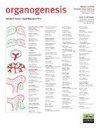应用封闭超声系统对脱细胞主动脉支架的表征和体内研究
IF 2.8
4区 生物学
Q4 BIOCHEMISTRY & MOLECULAR BIOLOGY
引用次数: 9
摘要
摘要通过脱细胞制备的基于细胞外基质(ECM)的生物支架越来越多地出现在组织工程应用中,因为它具有对细胞行为有显著影响的结构、生化和生物力学线索。因此,我们开发了一种封闭的超声脱细胞系统,以制备对ECM的不良影响最小的理想生物支架。在超声频率为170kHz的0.1%和2%十二烷基硫酸钠(SDS)溶液中进行10小时的脱细胞。以浸渍处理作为对照,将脱细胞效率与我们的系统进行比较。通过组织学染色和生化分析测定细胞去除和ECM结构。通过压痕试验研究了生物支架的生物力学性能,以测试生物支架的刚度、残余力和压缩力。此外,在大鼠体内进行植入,以研究宿主组织的反应。与天然组织相比,组织学染色和生化测定证实了ECM结构的保留,没有细胞性。此外,超声处理没有影响主动脉支架的硬度[N/mm]和残余力[N],除了压缩[%],与表现出较高SDS的天然组织相比,2%SDS显著降低,这对ECM结构具有不利影响。最后,在植入1周和5周后观察到最小的炎症反应。本研究报告了我们开发的封闭超声处理系统的新颖性,该系统用于制备组织工程应用的理想生物支架。本文章由计算机程序翻译,如有差异,请以英文原文为准。
Characterization and in vivo study of decellularized aortic scaffolds using closed sonication system
ABSTRACT Extracellular matrix (ECM) based bioscaffolds prepared by decellularization has increasingly emerged in tissue engineering application because it has structural, biochemical, and biomechanical cues that have dramatic effects upon cell behaviors. Therefore, we developed a closed sonication decellularization system to prepare ideal bioscaffolds with minimal adverse effects on the ECM. The decellularization was achieved at 170 kHz of ultrasound frequency in 0.1% and 2% Sodium Dodecyl Sulphate (SDS) solution for 10 hours. The immersion treatment as control was performed to compare the decellularization efficiency with our system. Cell removal and ECM structure were determined by histological staining and biochemical assay. Biomechanical properties were investigated by the indentation testing to test the stiffness, a residual force and compression of bioscaffolds. Additionally, in vivo implantation was performed in rat to investigate host tissue response. Compared to native tissues, histological staining and biochemical assay confirm the absence of cellularity with preservation of ECM structure. Moreover, sonication treatment has not affected the stiffness [N/mm] and a residual force [N] of the aortic scaffolds except for compression [%] which 2% SDS significantly decreased compared to native tissues showing higher SDS has a detrimental effect on ECM structure. Finally, minimal inflammatory response was observed after 1 and 5 weeks of implantation. This study reported that the novelty of our developed closed sonication system to prepare ideal bioscaffolds for tissue engineering applications.
求助全文
通过发布文献求助,成功后即可免费获取论文全文。
去求助
来源期刊

Organogenesis
BIOCHEMISTRY & MOLECULAR BIOLOGY-DEVELOPMENTAL BIOLOGY
CiteScore
4.10
自引率
4.30%
发文量
6
审稿时长
>12 weeks
期刊介绍:
Organogenesis is a peer-reviewed journal, available in print and online, that publishes significant advances on all aspects of organ development. The journal covers organogenesis in all multi-cellular organisms and also includes research into tissue engineering, artificial organs and organ substitutes.
The overriding criteria for publication in Organogenesis are originality, scientific merit and general interest. The audience of the journal consists primarily of researchers and advanced students of anatomy, developmental biology and tissue engineering.
The emphasis of the journal is on experimental papers (full-length and brief communications), but it will also publish reviews, hypotheses and commentaries. The Editors encourage the submission of addenda, which are essentially auto-commentaries on significant research recently published elsewhere with additional insights, new interpretations or speculations on a relevant topic. If you have interesting data or an original hypothesis about organ development or artificial organs, please send a pre-submission inquiry to the Editor-in-Chief. You will normally receive a reply within days. All manuscripts will be subjected to peer review, and accepted manuscripts will be posted to the electronic site of the journal immediately and will appear in print at the earliest opportunity thereafter.
 求助内容:
求助内容: 应助结果提醒方式:
应助结果提醒方式:


